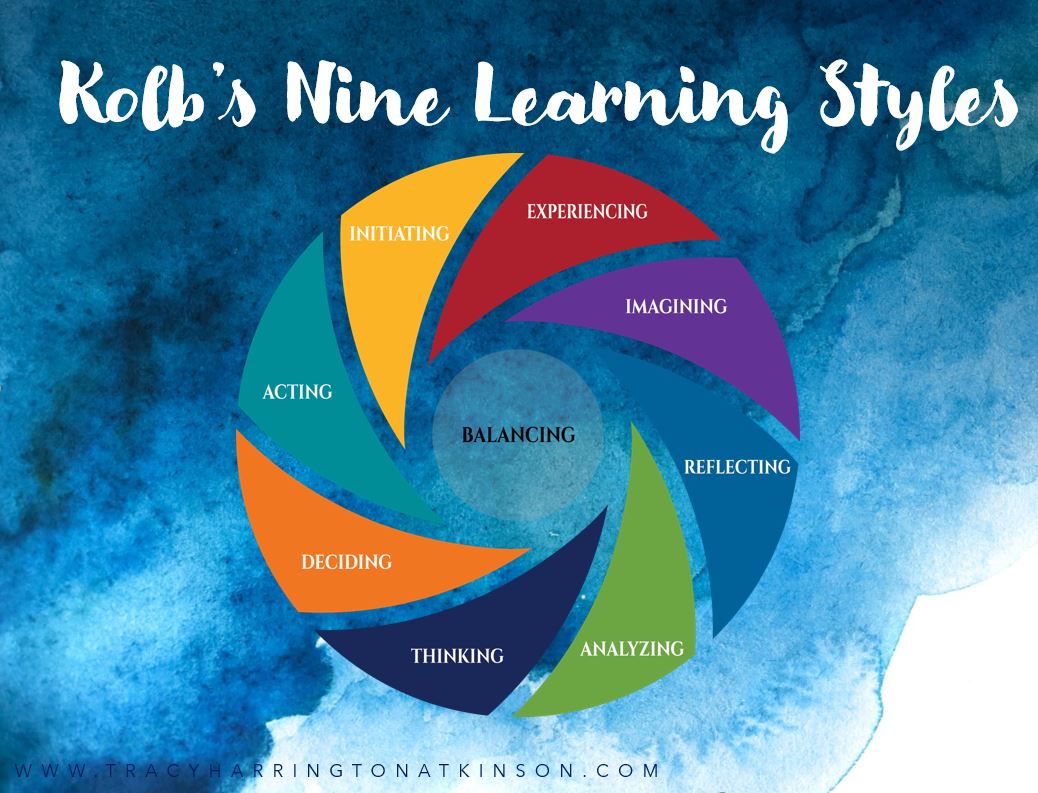
Each of us has a personalized learning style that has been molded by our experiences and needs. Kolb identifies nine different styles that add joy, satisfactions and also address different challenges. The unique approach used by Kolb is that everyone can use each of these learning styles in different situations. In fact, varying experiences may require a different learning approach. Additionally, these learning styles can be developed. Lastly, Kolb posits that each of these nine learning styles represent a whole person. A ‘complete and developed’ individual will possess that ability to access and use each of these nine styles.
To learn more details, download the pdf below.
Think of the nine learning styles as the varying ways to experience the learning cycle or as pieces of a larger puzzle.
Experiencing
Engaging. Empathetic. Interactive. Intuitive. Connected. Being present in whatever is going on. Mindful of surroundings and using the five senses, especially relishing in the experience of using the five senses: see, touch, taste, hear, smell.
Imagining
Creative. Trusting. Empathetic. Caring. Listening. Sensitive to others and the feelings of others. Quick ability to recognize patterns. Creating meaning from relationships. Learning is a creative process.
Reflecting
Careful. Reserved. Patient. Observer. Although may appear quiet, much learning and reflection is going on inside. Connects ideas and experiences through contemplation. Mulls over information.
Analyzing
Organized. Systems. Structure. Precision. Learning occurs through a methodical plan to minimize any mistakes. Use organization and objectivity. Prefer a lack of emotions in learning. Prefer researchable conditions.
Thinking
Skeptical. Controlled. Disciplined. Abstract. Generally prefers to work alone. Makes plans that are predictable and allows to gauge fallacies and problems. Problem-solver. Enjoys abstract and logical reasoning. Enjoys quantitative data.
Deciding
Direct. Practical. Efficient. Realistic. Will take risks to discover the best option. Considers and evaluates facts. Goal-oriented and measures progress toward goal. Likes critical feedback to guide learning and progress.
Acting
Assertive. Action-oriented. Courageous. Commanding. Prefers to be moving toward a learning goal. Will implement, execute and coordinate actions. Enjoys meeting needs. May have a continuous task list. Want to do it now and will tend to be fearless.
Initiating
Spontaneous. Outgoing. Generalities. Learns from failures and shrugs off the losses. Tends to be optimistic. Social. Networking. Proud of accomplishments and may focus on many things at one time.
Balancing
Resourceful. Adaptive. Collaborative. Identifies blind spots. Bridges differences. Quickly moves between acting, thinking, feeling and reflecting. Changes learning style to learning experiences. Sees value of all learning styles.
Sources:
Peterson, K. and Kolb, D. (2017). How You Learn Is How You Live: Using Nine Ways of Learning to Transform Your Life. Berrett-Koehler Publishers. Available: https://amzn.to/3bTQACp
Subscribe to our YouTube Channel by clicking here.
By Tracy AtkinsonTracy Atkinson, mother of six, lives in the Southwest with her husband and spirited long-haired miniature dachshunds. She is a teacher, having taught elementary school to higher education, holding degrees in elementary education and an EDS in higher education. Her passion is researching, studying and investigating the attributes related to self-directed learners and learning styles. She has published several titles, including MBTI Learning Styles: A Practical Approach, The Art of Learning Journals, Calais: The Annals of the Hidden, Lemosa: The Annals of the Hidden, Book Two, Rachel’s 8 and Securing Your Tent. She is currently working on a non-fiction text exploring the attributes of self-directed learners: The Five Characteristics of Self-directed Learners.

Comments are closed